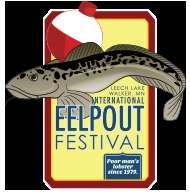Eelpout Festival
| Eelpout Festival | |
|---|---|
 Official Logo of the Eelpout Festival | |
| Genre | Festival |
| Dates | February 20–23, 2014 |
| Location(s) | Walker, Minnesota |
| Years active | 1979–Present |
| Attendance | 11,000 (2012) |
| Website | |
| http://www.eelpoutfestival.com/ | |
The International Eelpout Festival is an annual gathering held in the town of Walker, Minnesota. It celebrates the rather unfortunate looking eelpout (or burbot, scientific name Lota lota), an indigenous bottom dwelling fish that inhabits the regions lakes, in some cases being found as deep as 300m. The fish itself is described as a cross between a catfish and eel, giving it a slender disposition but retaining a tapered midsection with a full complement of pectoral and caudal fins. While Lota lota is known locally as eelpout, eelpout also may refer to a family of marine fishes. Leech Lake is known for its exceptional walleye fishing, making this festival a delightful banner for the often forgotten eelpout.[1][2]
History
The first Eelpout Festival was held in February 1979 and has continued into the present. The celebration is held during one of the coldest periods of the year, and temperatures often reach well below zero.[3]
Attractions
Numerous unique activities can be found at the Festival. Attendees are invited to jump into the frigid waters of Leech Lake in a breathtaking event known as the Polar Plunge, kiss an eelpout for good luck, or observe the frozen wet T-shirt contest. There is a black-tie dinner and of course, a prize for the largest eelpout. The events are designed to cater to a wide range of audiences and family activities are plentiful.[1]
Environment
Leech Lake is well known among locals for its abundance of walleye, bass, Northern pike, sunfish and muskellunge. Eelpout are frequently caught only during the winter months. Leech Lake is the third largest lake in Minnesota covering 102,947.83 acres, with 195 miles of shoreline, and a maximum depth of 150 feet. Temperatures in February average a high of 25 degrees Fahrenheit and a low of 5 degrees.[3]